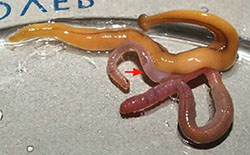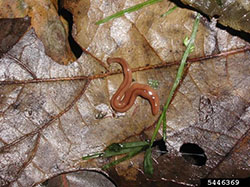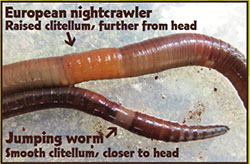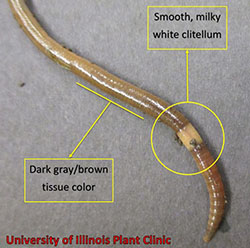Home → Pests → Other Critters → Invasive Worms
Invasive Worms
Due to our history of glaciation, there are no native earthworms in Maine. Non-native earthworms from Europe (such as nightcrawlers) have become well established here through early colonial trading. Though they are beneficial to our gardens, earthworms can have destructive effects on our forests.
On this Page:
Hammerhead Flatworms
Hammerhead flatworms, also known as land planaria and terrestrial flatworms, feed on other soft-bodied invertebrates including snails, slugs, and other worm species. Some species produce the same toxin as puffer fish (tetrodotoxin), so care should be taken if handled. They do not have the ability to inject the toxin into humans or pets, and taste extremely bad to pets so the risk of ingestion by pets is low. Do not cut these worms to kill them – they can multiply this way. Instead, either preserve them in rubbing alcohol to submit to the University of Maine Cooperative Extension Diagnostic Lab, or put them in a bag in the freezer for 24 hours and then dispose in the trash.
Since 2022, there have been some sightings of invasive hammerhead flatworms in southern and central Maine. Help us track locations of hammerhead worms by uploading observations to iNaturalist.
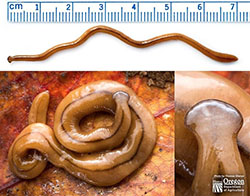
Bipalium adventitium is one of the species that has been detected in Maine. This species grows up to 3.1 inches and feeds primarily on earthworms.
Click on images to view full-size
Identification and Control Information
- Hammerhead Flatworms and Other Land Planaria of Eastern North America – Online Article & Excellent Identification Guide, PennState Extension
- Terrestrial Flatworms, Land Planarians & Hammerhead Worms - Online factsheet, NC State Extension
Jumping Worms (Amynthas)
Amynthas worms are a type of earthworm native to East Asia. They are smaller than nightcrawlers, reproduce rapidly, are much more active, and have a more voracious appetite. This rapid life cycle and ability to reproduce asexually gives them a competitive edge over native organisms, and even over nightcrawlers. When disturbed, Amynthas worms jump and thrash about, behaving like a threatened snake.
Amynthas worms are known and sold for bait and composting under a variety of names including snake worms, Alabama jumper, jumping worms, Asian Amynthas worm. They are in the genus Amynthas, and distinguishing between the several species in the genus can be difficult. All species in this genus are considered invasive in Maine. It is illegal to import them into Maine (or to propagate or possess them) without a wildlife importation permit from the Maine Department of Inland Fisheries and Wildlife (MDIFW).
Click on images to view full-size
Identification and Control Information
More Information & Fact Sheets
- Jumping Worm Report Form - Maine Agriculture, Conservation and Forestry
- Jumping Worm History in Maine - Maine Agriculture, Conservation and Forestry
- Invasive Jumping Worm Frequently Asked Questions - UMass Extension
- Jumping/Crazy/Snake Worms Fact Sheet - UMass Extension
- Factsheet for Homeowners - Cornell
- Impacts and Implications of Non-native Earthworms in North America
- MDIFW's Fish & Wildlife in Captivity
- Jumping Worms Guide - Oregon State
[Hammerhead Worm Photos, left to right: Oregon Department of Agriculture (Flickr, CC BY-NC-ND 2.0), Leslie J. Mehrhoff, University of Connecticut, Bugwood.org, Aydin Örstan (Flickr, CC BY-NC-ND 2.0)]
[Jumping Worm Photos, left to right: Amynthas Worm and Nightcrawler, Photo courtesy Wisconsin DNR, Amynthas Worm clitellum, Photo courtesy University of Illinois]
